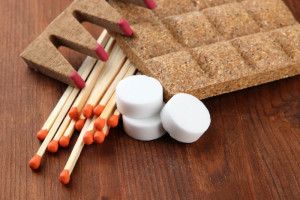As the temperatures outside continue to drop, fireplaces are once again being used as a source of heat and comfort in our homes. However, this also leads to the age old debate: what is the best fire starter?
While everyone has their favorite method for starting a fire, there are very few truly “right” or “wrong” ways to do it. Below are several different fire starting options. This year, branch out from your favorite to try a new one!
- Fire starting logs. Fire starting logs are composite chemicals logs designed to ignite quickly and burn for long periods of time. Popular brands like Duraflame can often be found at most grocery stores. While fire starting logs provide a fast and easy way to start your fire they do contain chemicals; make sure the damper is completely open to provide proper ventilation. Likewise, if you are planning on cooking with your fire make sure the fire starting log has completely burned off to avoid chemical transfer onto the food.
- Fatwood kindling. If you like the ease of fire starting logs but don’t like the chemicals, try fatwood kindling. Made from the pine stumps left over from logging, fatwood kindling ignites quickly and can burn for up to 20 minutes, giving your seasoned firewood plenty of time to ignite and begin to burn on its own. Because it is natural wood, fatwood kindling may take several minutes to fully ignite before it burns hot enough to light other wood.
- Dryer lint. Re-purpose two things at once by using cardboard tubes and dryer lint to create your own fire starters! Set aside your dryer lint and pack it into the cardboard tubes left over from paper towels or toilet paper; while the tubes should be full, avoid over packing them so there is still room for oxygen to circulate. Because lint ignites and burns quickly, two or three rolls may be needed to successfully start a fire.
- Wine corks. If your family is regular wine drinkers, you can re-purpose the corks to create easy fire starters! Simply keep the corks in a sealed jar with rubbing alcohol; when needed, toss a couple corks onto the kindling and light! While the cork jar can double as a decorative piece, like all fire starters it should be stored away from the fireplace for safety reasons.
- Fire starter gel. These sticky gels are similar to lighter fluid and can be applied directly to the firewood. When lit, they burn intensely for several minutes, making them a fast and effective way to start a fire. However, because they are a chemical product it is important to follow the same rules as when using fire starting logs; likewise, some homeowners do not like the chemical smell they can create.
- Egg cartons. Use leftover materials from around the house to create your own compact fire starters in an egg carton. Fill the compartments of a cardboard egg carton with combustible materials such as sawdust, dryer lint, or shredded paper. Next, pour melted wax from candle nubs or broken crayons over each compartment. Once the wax cools, the compartments can be broken apart into a dozen compact fire starters.

